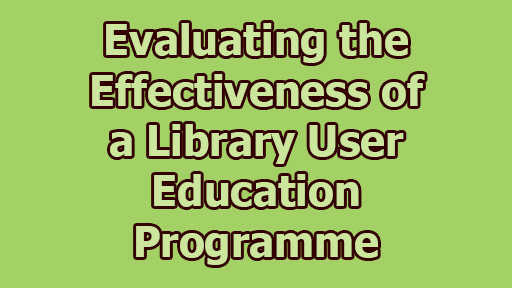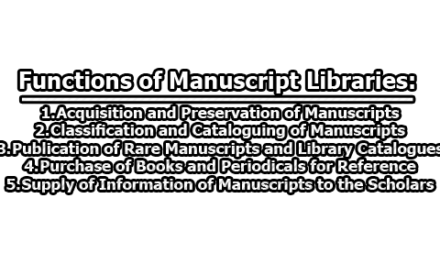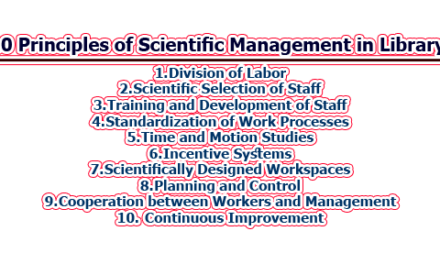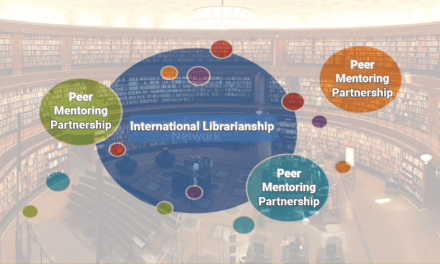Evaluating the Effectiveness of a Library User Education Programme:
In an era where information is readily accessible at our fingertips, libraries continue to play a crucial role in facilitating learning and research. To ensure that library users make the most of available resources, many institutions implement Library User Education (LUE) programme. This article explores the scope, methods, and the pressing need for evaluating the effectiveness of a library user education programme.
Scope of Evaluation:
The scope of evaluating a Library User Education programme is broad and multifaceted. To comprehensively assess its effectiveness, various aspects must be considered:
1. Learning Outcomes: One of the primary focuses of evaluation is to measure the impact of the programme on the users’ learning outcomes. This involves assessing whether participants have acquired the necessary skills and knowledge to locate, evaluate, and use information resources effectively.
- Skills and Knowledge Acquisition: This is at the core of any educational programme. Evaluating whether participants have acquired the necessary skills, such as search strategies, citation methods, and database navigation, is essential. Moreover, assessing their knowledge in terms of subject-specific resources and research methodologies is equally crucial.
- Effective Information Use: Beyond mere acquisition, the evaluation should focus on whether participants can effectively apply the skills and knowledge gained in their academic or research pursuits. Can they locate relevant sources, critically evaluate information, and use it to support their work?
2. User Satisfaction: Gathering feedback from participants is crucial in understanding their level of satisfaction with the LUE programme. This feedback can highlight areas that require improvement and provide insights into the overall user experience.
- Programme Experience: Gathering feedback from participants regarding their experiences with the LUE programme provides valuable insights. It can reveal their level of engagement, the clarity of instructional materials, and the overall quality of the educational experience.
- Areas for Improvement: User satisfaction data can pinpoint specific areas that require improvement. It may uncover issues with course content, delivery methods, or resource accessibility, enabling program administrators to make targeted enhancements.
3. Resource Utilization: Evaluation should also include an analysis of how well participants are utilizing library resources. Are they making efficient use of databases, catalogs, and reference materials? This data can help libraries optimize their resource allocation.
- Database and Catalog Usage: Evaluating how participants utilize library resources, including databases, catalogs, and reference materials, is essential. This data can identify popular resources, underutilized ones, and potential gaps in resource coverage.
- Resource Optimization: Armed with usage statistics, libraries can optimize their resource allocation. They can make informed decisions about renewing subscriptions, acquiring new resources, or discontinuing underused ones.
4. Retention and Graduation Rates: For academic libraries, tracking the retention and graduation rates of students who have participated in LUE programmes can be indicative of their effectiveness in supporting academic success.
- Academic Success Metrics: Tracking the retention and graduation rates of students who have participated in LUE programmes is especially relevant for academic libraries. Higher retention and graduation rates among program participants may suggest that the programme is contributing to academic success and student persistence.
5. Information Literacy Development: Assessing the development of information literacy skills is a core component of evaluating LUE programmes. This includes evaluating skills related to information retrieval, critical thinking, and ethical use of information.
- Information Retrieval Skills: Evaluating participants’ ability to retrieve information efficiently from various sources, both within and beyond the library’s collections, is critical. This includes assessing their search strategies, keyword selection, and database usage.
- Critical Thinking: Information literacy also encompasses critical thinking skills. Participants should be evaluated on their ability to critically evaluate sources for reliability, bias, and relevance.
- Ethical Use of Information: Assessing participants’ understanding and application of ethical principles related to information use, including proper citation and avoiding plagiarism, is vital.
6. Long-term Impact: It’s essential to consider the long-term impact of the programme.
- Application of Skills: It is crucial to investigate whether users continue to apply the skills and knowledge gained from the LUE programme beyond their immediate educational context. Are they using these skills in their professional careers or personal lives?
- Lifelong Learning: Assessing whether the programme instills a culture of lifelong learning and information literacy is essential. Do users exhibit a continued interest in seeking and evaluating information, even after completing their academic studies?
Methods of Evaluation:
To evaluate a Library User Education programme effectively, a combination of qualitative and quantitative methods can be employed. These methods provide a well-rounded view of the programme’s impact and areas for improvement:
1. Surveys and Questionnaires: Gathering feedback from participants through surveys and questionnaires can provide valuable insights into their experiences and perceptions of the programme. Questions can cover topics such as content relevance, teaching methods, and overall satisfaction.
- Purpose: Surveys and questionnaires are excellent tools for collecting quantitative data on participants’ experiences and perceptions of the LUE programme.
- Content: Questions should cover a range of topics, including the relevance of the programme’s content, the effectiveness of teaching methods, the accessibility of resources, and overall satisfaction.
- Benefits: Surveys and questionnaires allow for standardized data collection, making it easier to quantify user opinions and identify trends or patterns in responses.
- Considerations: Care should be taken in designing unbiased and clear questions to ensure accurate and meaningful responses.
2. Assessment of Learning Outcomes: Pre- and post-assessments can measure the effectiveness of the programme in terms of knowledge and skill acquisition. This can be done through quizzes, tests, or practical assignments that assess participants’ information literacy competencies.
- Purpose: Pre- and post-assessments are essential for measuring the knowledge and skill acquisition of participants.
- Content: These assessments can include quizzes, tests, practical assignments, or rubrics that assess participants’ information literacy competencies.
- Benefits: These assessments provide concrete, measurable data on the impact of the programme on participants’ learning outcomes.
- Considerations: The assessments should align closely with the programme’s learning objectives, and reliability and validity should be ensured.
3. Focus Groups and Interviews: Conducting focus groups or interviews with participants allows for in-depth exploration of their experiences. Qualitative data can reveal nuances that quantitative data might miss, such as the emotional impact of the programme.
- Purpose: Qualitative methods like focus groups and interviews delve into the nuanced experiences and emotions of participants.
- Content: Open-ended questions can be used to explore participants’ thoughts, feelings, and perceptions about the programme.
- Benefits: These methods uncover qualitative insights, shedding light on the emotional and experiential aspects that quantitative data might not capture.
- Considerations: Focus groups and interviews require skilled facilitation and transcription/analysis, and they may involve a smaller sample size compared to surveys.
4. Usage Statistics: Analyzing usage statistics of library resources can provide data on how frequently participants access and utilize these resources after completing the programme. This can help assess the practical application of skills learned.
- Purpose: Analyzing usage statistics of library resources post-programme helps assess the practical application of the skills learned.
- Content: Data can include resource access frequency, types of resources accessed, and the duration of use.
- Benefits: Usage statistics provide concrete evidence of whether participants are applying what they’ve learned in the programme to access and use library resources.
- Considerations: It’s important to distinguish between correlation and causation when interpreting usage statistics, as other factors may influence resource use.
5. Longitudinal Studies: To gauge the long-term impact of LUE programmes, longitudinal studies tracking participants’ progress and information literacy development over time can be conducted.
- Purpose: Longitudinal studies track participants’ progress and information literacy development over an extended period.
- Content: Data collection may involve multiple assessments or surveys at different points in time, allowing for the measurement of long-term impacts.
- Benefits: Longitudinal studies provide insights into whether the skills and knowledge gained in the programme persist over time and contribute to ongoing information literacy.
- Considerations: These studies require a longer-term commitment and may require strategies to mitigate participant attrition over time.
6. Comparative Analysis: Comparing the performance and information literacy skills of LUE participants with those who did not participate in the programme can help determine its unique impact.
- Purpose: Comparing the performance and information literacy skills of LUE participants with those who did not participate helps determine the unique impact of the programme.
- Content: Data can include performance metrics, such as academic achievement or information retrieval proficiency, for both participant and non-participant groups.
- Benefits: Comparative analysis allows for a direct assessment of the programme’s influence by isolating its effects from other variables.
- Considerations: Care should be taken to select appropriate comparison groups and control for confounding factors that could influence outcomes.
The Need for Evaluation of Library User Education:
The need for the evaluation of Library User Education programmes is undeniable and is driven by several compelling reasons:
1. Accountability: Libraries, particularly in educational institutions, are accountable for their expenditures and resource allocation. Evaluations provide evidence of the effectiveness of LUE programmes, justifying their existence and funding.
2. Continuous Improvement: Evaluation helps identify areas that require improvement. Regular assessments enable libraries to refine their programmes, ensuring they remain relevant and effective in meeting the evolving needs of users.
3. Resource Optimization: By understanding how participants utilize library resources, libraries can allocate budgets more efficiently, ensuring that funds are directed towards resources and services that have the greatest impact on user education.
4. Alignment with Objectives: LUE programmes are often aligned with institutional objectives related to student success and information literacy. Evaluation ensures that these programmes contribute effectively to achieving these goals.
5. Enhanced User Experience: Feedback from evaluations allows libraries to tailor LUE programmes to better suit the preferences and needs of their users, ultimately enhancing their experience with library services.
6. Data-Driven Decision-Making: Evaluations provide libraries with valuable data that can inform decision-making processes. This data-driven approach helps in making informed choices about programme enhancements and resource allocation.
7. Demonstrating Value: Evaluation results can be used to demonstrate the value of libraries and their contribution to the educational mission of institutions. This is especially important when libraries are seeking support or recognition.
It is apparent that Library User Education programmes are integral to ensuring that library users can navigate the vast landscape of information effectively. However, their success hinges on thorough evaluation. Assessing learning outcomes, user satisfaction, resource utilization, and the long-term impact of these programmes is essential to their continuous improvement and alignment with institutional goals. Employing a variety of evaluation methods, from surveys and assessments to qualitative interviews and longitudinal studies, provides a comprehensive view of their effectiveness. Ultimately, the evaluation of Library User Education programmes is not just a process of accountability; it is a strategic endeavor to enhance user experiences and empower individuals with vital information literacy skills in an increasingly information-driven world.
References:
- Breivik, P. S., & Gee, E. G. (2009). Information literacy: Developing students as independent learners. Libraries Unlimited.
- Fister, B. (2011). Learner-Centered Pedagogy and the Library: The Importance of Process. American Library Association.
- Heath, F., Ball, D. W., & Patrick, J. D. (2008). Evaluating the Impact of Library Instruction Methods on the Quality of Student Research. portal: Libraries and the Academy, 8(4), 383-396.
- Hernon, P., & Dugan, R. E. (2002). Action Research and the Academic Reference Librarian: A Review of the Literature 1980–2000. College & Research Libraries, 63(5), 423-442.
- Julien, H., & Given, L. M. (2003). Faculty-librarian relationships in the information literacy context: A content analysis of librarian-generated correspondence. Library & Information Science Research, 25(3), 245-261.
- Kuhlthau, C. C., & Maniotes, L. K. (2010). Building guided inquiry teams for 21st-century learners. Libraries Unlimited.
- Oakleaf, M. (2010). Value of Academic Libraries: A Comprehensive Research Review and Report. Association of College and Research Libraries.
- Radniecki, T. S. (2013). Assessing and evaluating information literacy. In Teaching Information Literacy Threshold Concepts (pp. 161-186). Chandos Publishing.
- Shank, J. D. (2017). The blended librarian: A blueprint for redefining the teaching and learning role of academic librarians. American Library Association.
- Wong, G. K., & Cheung, A. K. (2015). Measuring the impact of library instruction on freshman success and persistence: A quantitative analysis. Journal of Academic Librarianship, 41(5), 630-638.

Library Lecturer at Nurul Amin Degree College










